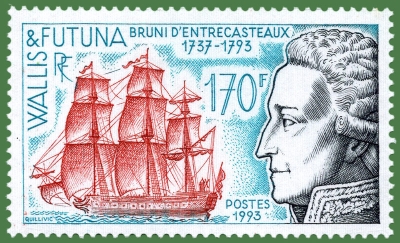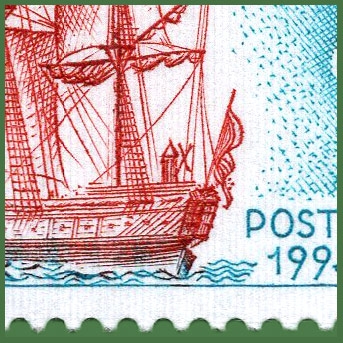-
200 years from death of Admiral Bruni d'Entrecasteaux
Wallis and Futuna 1993.07.12
In issue: Stamp(s): 1
-
Number by catalogue: Michel: 645 Yvert: 453
Perforation type: 13 ¼x13 ¼
Subject:
170 French Pacific francs.
Admiral d'Entrecasteaux* and his frigate Recherche** with a feed mill.
Additional:
*Antoine Raymond Joseph de Bruni, chevalier d'Entrecasteaux (8 November 1737 – 21 July 1793) was a French naval officer, explorer and colonial governor. He is perhaps best known for his exploration of the Australian coast in 1792, while searching for the La Pérouse expedition.
In September 1791, the French Assembly decided to send an expedition in search of Jean-François de La Pérouse, who had not been heard of since leaving Botany Bay in March 1788. Bruni d'Entrecasteaux was selected to command this expedition. He was given a frigate, Recherche** (500 tons), with Lieutenant Jean-Louis d'Hesmity-d'Auribeau as his second-in-command and Élisabeth Rossel among the other officers. A similar ship, Espérance, was placed under Jean-Michel Huon de Kermadec, with de Trobriand as his second-in-command.
The search for the frigates of Laperouse unsuccessfully continued for less than 2 years and ended after Joseph de Bruni died of scurvy on July 21, 1793.
**The Recherche was a 20-gun Marsouin-class scow of the French Navy, later reclassified as a 12-gun frigate. She earned fame as one of the ships of Bruni d'Entrecasteaux' expedition, along with Espérance. Recherche Bay in Tasmania was named after her.
The ship was built as Truite and served under this name until July 1791, when she was renamed to Recherche and recommissioned as a 12-gun frigate.
She departed from Brest on 29 September 1791 for an exploration mission in search of Lapérouse, sailing to New Caledonia. Bruni d'Entrecasteaux died aboard on 21 July 1793.
On 28 October 1793, she was captured by the Dutch at Surabaya, only to be restituted to France in February 1794. In September, she was sold to Holland, and two months later she was sold for scrap.
It is noteworthy that one of the important buildings of the frigate was a windmill located at the stern of the vessel.
In this image you can see the windmill well.
Topics: Windmills




